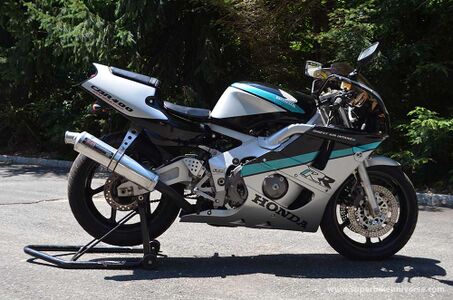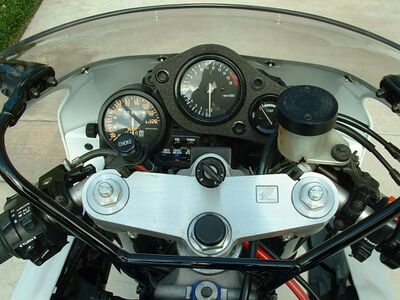Honda CBR400RR
The Honda CBR400RR sports motorcycle model appeared on December 15, 1987, and official sales began on January 19, 1988. The model was a continuation of the Honda CBR400R Aero, having received a number of technical differences - from the aluminum frame to the engine. Currently, Aero is extremely rare on the market, and in fact it is not a CBR400RR, so it will not be considered in this review.
Lineup:
Main competitors:
The Honda CBR400RR was based on an in-line 4-cylinder liquid-cooled engine with a volume of 399 cc, producing up to 59 hp. power and up to 39 Nm of torque. Since 1993, Japanese legislation has been updated, forcing thereby to reduce the maximum power to 53 hp. and limit the speed to 180 km / h.
This engine, with minor modifications, was also installed on the Honda CB-1 model.
In February 1990, the Honda CBR 400 RR model undergoes a restyling (the NC23 generation is changed to NC29 , according to the frame number), receiving updates in appearance and technical part: a new cast aluminum frame (instead of tubular), new intake system, new carburetors (VP01 instead of VG04), lighter pistons, new rear swingarm, new ignition (PGM), new wheels.
In 1993, in addition to changing the engine power (reduced to 53 hp, as required by new legislation), the CBR400RR model receives a new cartridge fork with rebound damping and other rear suspension settings.
1999 was the last year of production of the model, after which it finally left the market and did not receive further development.
Photos
Specifications
Specifications Honda CBR400RR:
| Model | Honda CBR400RR |
|---|---|
| Motorcycle type | sports |
| Release year | 1987 (1988) -1999 |
| Frame | aluminum tubular - CBR400RR (NC23)
aluminum cast - CBR400RR (NC29) |
| Engine type | 4-cylinder, 4-stroke, in-line |
| Working volume | 399 cm³ |
| Bore / stroke | 55.0 x 42.0 mm |
| Compression ratio | 11.3: 1 - CBR400RR (1987-1992)
11.7: 1 - CBR400RR (1993-1999) |
| Cooling | liquid |
| Number of valves per cylinder | DOHC, 4 valves per cylinder, timing - gears |
| Fuel supply system | Carburetor, 4x Keihin VG04 - CBR400RR (NC23)
carburetor, 4x Keihin VP01 - CBR400RR (NC29) |
| Ignition type | all-transistor - CBR400RR (NC23)
fully transistor (PGM) - CBR400RR (NC29) |
| Maximum power | 59 hp (43.4 kW) @ 12,500 rpm - CBR400RR (NC23)
59 h.p. (43.4 kW) @ 13000 rpm - CBR400RR (NC29), 1990-1992 53 h.p. (39.0 kW) @ 13000 rpm - CBR400RR (NC29), 1993-1999 |
| Maximum torque | 39.0 Nm (4.0 kg * m) @ 10,000 rpm - CBR400RR (1987-1992)
35.0 Nm (3.6 kg * m) @ 10,000 rpm - CBR400RR (1993-1999) |
| Gearbox | 6-speed |
| Drive type | chain |
| Front tire size | 120/60 R17 55H |
| Rear tire size | 150/60 R18 67H - CBR400RR (NC23)
150/60 R17 66H - CBR400RR (NC29) |
| Front brakes | 2 discs, 296 mm, 4-piston calipers |
| Rear brakes | 1 disc, 220 mm, 1-piston caliper |
| Front suspension | 41mm Telescopic Fork (preload adjustable) - CBR400RR (1987-1992)
41mm telescopic cartridge fork (adjustable preload and rebound damping) - CBR400RR (1993-1999) |
| Rear suspension | linkage with monoshock (adjustable preload and rebound damping) |
| Length | 2020 mm - CBR400RR (NC23)
1990 mm - CBR400RR (NC29) |
| Width | 690 mm - CBR400RR (NC23)
670 mm - CBR400RR (NC29) |
| Height | 1110 mm - CBR400RR (NC23)
1080 mm - CBR400RR (NC29) |
| Wheelbase | 1370 mm - CBR400RR (NC23)
1365 mm - CBR400RR (NC29) |
| Saddle height | 765 mm - CBR400RR (NC23)
750 mm - CBR400RR (NC29) |
| Minimum ground clearance | 120 mm - CBR400RR (NC23)
125 mm - CBR400RR (NC29) |
| Acceleration to 100 km / h | 4.5 sec |
| Maximum speed | 185 km / h |
| Fuel tank capacity | 15.0 l |
| Motorcycle weight (dry) | 162 kg |
| Motorcycle weight (curb) | 179 kg |
Documentation


